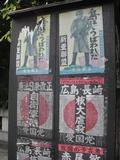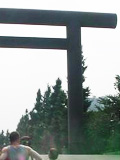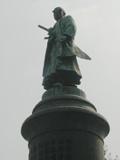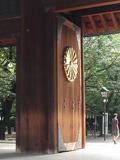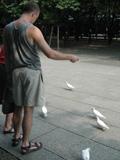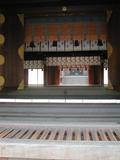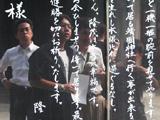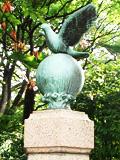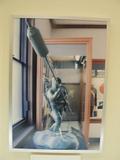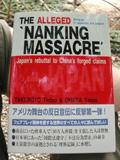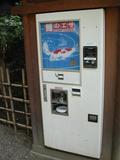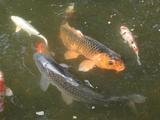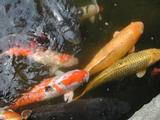|
Yasukuni Jinjya
|
|||
|
A religious monument decorated with cannons and kamikaze submarines, this may well be the most controversial war memorial in the world. Yasukuni Jinjya - Yasukuni means "peaceful country" and Jinjya is Japanese for "shrine" (place of worship for the Shinto faith). Located in Tokyo, Yasukuni Jinjya is a Shinto shrine built in 1869 to honor Japan's war dead. As I was preparing for my July 2001 trip to Japan, I received this email from a young Japanese friend Sanae, sent from her mobile phone:
YESTERDAY, I VISITED YASUKUNI SHRINE TO PRAY FOR THOSE WHO DEDICATED THEIR LIVES TO THIS COUNTRY. I WAS REALLY IMPRESSED BY EVERYTHNG IN THAT SHRINE AND BLAMED MYSELF FOR MY LAZINESS OF NOT GOING THERE. FORTUNATELY, AS IT HAPPENS, I COULD HAVE SEEN ANNUAL FESTIVAL CALLED "MITAMA MATSURI", MEANINGA FESTIVAL TO ENSHRINE THE SPIRIT OF THE DEAD. SEENG THE FESTIVAL AROUSE MY GRATITUDE TO OUR ANCESTORS WHO MADE ALL POSSIBLE EFFORTS TO MAKE THIS NATION BETTER.MITAMA MATSURI, IS ONLY HELD 4 DAYS(JULY 13TH TO 16TH. BUT IF YOU ARE INTERESTED, I CAN TAKE YOU THERE. Mention of Yasukuni Jinjya appears periodically in the modern Japanese press. It's a controversial place, because in addition to the thousands of soldiers honored, six war criminals are buried there - folks who ran Japan's military during World War II and were later hung after a guilty verdict by an International Warcrimes Tribunal. These men are reviled still outside of Japan, particularly by many Chinese and Korean folks who saw their countrymen abused under their orders. So when the Prime Minister elects to pay a patriotic visit to this shrine to honor the war dead, Chinese and Korean diplomats cry foul, foreign journalists cry nationalism, Japanese folks debate their national pride, and much ink is spilled. Of course being a center of controvery makes it all the more attractive a place to visit. The combination of war history, traditional ceremony and religious architecture makes Yasukuni Jinjya a fascinating afternoon. As we approached in a cab on a late July midday, rising sun adorned flyers hung on the streetsigns and trees. Sanae identified one as admonishing modern Japanese to respect their ancestors; she said most all of these papers had a right-wing slant (written in English on one was this message: "The U.S.A. should repent before Jesus Christ!").
A large structure both solid and ethereal stood off to the side. Sanae explained it's an everflowing fountain providing water to all the Japanese soldiers who have died of thirst.
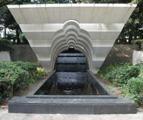
enter the shrine Sanae caught us walking ahead and called us to a large stone cistern. There she instructed us to clean our hands and mouth before we could enter the Shrine.
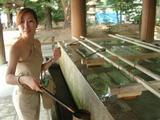
At the end of the path stood the shrine, enshrouded in a chrysthanemum cloth, parted down the middle for a peek up the Shinto skirt.
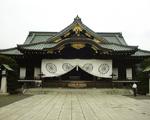
honor the dead - pray for calm
Here honoring the war dead begs the same behaviour advised at any Shinto shrine - toss coins between the wooden slats at the front, then clap your hands and bow your head.
Through the shrine building, empty with only tatami mats, you could see another building, where white robed Shinto monks scurried and sat, going about their religious duties at some distance from the visiting Americans and honoring Japanese. I took a picture, and I was asked not to immediately afterwards. In front of the shrine, inked on a large black slate, behind some plexiglass - the final words of a 20 year old kamikaze pilot, a letter to his mother. Sanae translated; roughly - I am fated to die, I attack America because I am Japanese, I love being Japanese, I love Japan, I love you Mom. Below the inscription, photocopies of the letter were available (none translated into English, oddly enough), and each Japanese visitor seemed to take one as a matter of course.
peace and war
Near the shrine, Ikebana flower arrangements on display, young women in kimonos shuffling about, shinto trinkets for sale. Just past the grounds of the shrine, cannons, artillery and brave bronze statues, including
Perhaps the most staggering celebration of futility I saw was the Kaiten, a human torpedo. I'd heard of young men strapping themselves into tin cans with wings and flying themselves into American targets. But there's something somehow more stunning about strapping yourself into a water-borne metal coccoon and aiming for the side of a ship. It's got to be a drawn out fate, and it seems many of them were sighted before they could do any damage, and so they were shot out of the water.
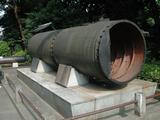
The Yasukuni museum had a human torpedo casing outside. Sanae saw a family gazing over the device and excused herself to share some history with them.
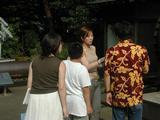
At the museum gift shop, Sanae purchased a book -
over troubled waters Not all at the park was dreadful serious, mourning or patriotic. Behind all the discarded war machines was a traditional Japanese garden with a waterfall spilling into a pond broken up by small islands with bridges between.
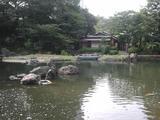
Yasukuni has a loaded feel to it. The bulk of the material celebrates World War II; all of this quite instense because Japan lost this war, and the toll on human suffering was immense. All around are tributes to those folks who forestalled the defeat of their country with valiant, if suicidal behaviour. The heroes who stared the sure fate of death and loss in the face and said, "I'm proud to be Japanese;" at least that's how the museum portrays their history. I was concerned somehow that I would be a target there, or at least feel unwelcome. But Yasukuni Jinjya has little to do with active antipathy for any one enemy or analysis of loss; it's a celebration of futility and patriotism. The cries of dying soldiers shouted in a fiery blaze of glory echo quite loud here. Perhaps the quiet moments in front of the shrine are when Japanese folks reflect on what resulted from their failed vision for a "co-prosperity asian sphere." But the rest of Yasukuni Jinjya feeds its visitors a quiet pathological pride, now passed. It's as though the entire place is a dare. Links (August 2001):
|
justin's links by justin hall: contact
